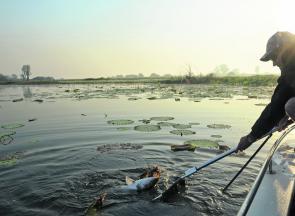Securing a good fish with a landing net should be a dead easy process, but it’s amazing how often it all goes wrong at the very last moment! Here’s how to do it the right way…
As explained last month, far too many great fish escape capture in the final seconds of any encounter. When that whopper eventually swims into view after an epic battle, it’s natural to experience a strong desire to simply heave the catch out of the water or onto the bank as quickly as possible. However, this desire can often lead to disaster!
Last time around, we looked at the most common options for landing fish, including lifting them on the line or leader, beaching them, washing them out with the help of wave action, or grabbing the catch by the jaw or tail wrist. In the process, we decided that the safest and best option for boat anglers or those on higher banks and platforms was to use a landing net or a gaff, and that a net was the most versatile option.
A landing net is definitely the most common tool used to land fish, but many people make a mess of the netting process, and the next trophy fish to be knocked from the hook by an overly enthusiastic net-wielder certainly won’t be the last!
The most important aspect of using a landing net is to remember that securing a fish safely in a net has absolutely nothing in common with catching butterflies! Forget about swooshing, swooping, dipping and scooping at a flailing fish. Instead, always take the following steps:
1. Place the net in the water so that the front of the hoop is well submerged and the back of the hoop (where the handle is connected) is roughly flush with the water’s surface.
2. Using the rod, bring the hooked fish to the net and swim the fish into the net headfirst. If you’re fishing on your own, you’ll need to perform these actions yourself, holding the net handle in one hand and the rod in the other. If you need to reel in line during this process, tuck the net handle under your arm.
3. Relax the pressure on the line just before you or your assistant begins to lift the net from the water. This relaxation of pressure induces the fish to dive deeper into the net, making sure you securely restrain it.
So, are you all set with nets? This is such an important part of fishing, I’m going to run through the instructions one more time: Submerge the net, bring the fish to the net, swim the catch into the net headfirst, reduce pressure on the line, smoothly lift the net.
Never, ever, ever chase a swimming fish with a net, nor attempt to net the fish tail first. Such efforts often result in disaster, because the fish can swim much faster than you can move the submerged net through the water (especially one of the modern, fish-friendly knotless varieties, such as an Environet). The fish almost always evades capture in this situation, often breaking the line or shedding the hook in the process
Up to a point, a larger net with a wider hoop is generally easier to use and more efficient than a smaller net. However, a landing net stops being so useful when dealing with fish over 20kg in weight or 1.4m in length. You can best land these larger fish by using a gaff (especially if you intend to kill and keep the fish), and that’s what we’ll be looking at next time in ‘Back To Basics’.
1
Don’t chase the fish with the net. Angler and net man need to work together to ensure the catch goes into the mesh head first. The biggest danger is snagging an exposed hook point on the outside of the net and ripping the lure out of the fish.
2
That’s the way you do it!
3
It’s especially important with knot-less mesh nets, like the very popular Environets and their clones, to bring the fish to the net and not vice versa.
4
Safely in the net!
Reads: 1331







